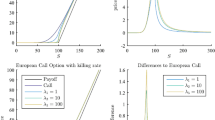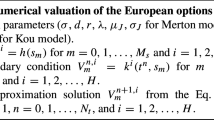Abstract
We propose a positivity preserving implicit Euler–Maruyama scheme for a jump-extended Cox–Ingersoll–Ross (CIR) process where the jumps are governed by a compensated spectrally positive \(\alpha \)-stable process for \(\alpha \in (1,2)\). Different to the existing positivity preserving numerical schemes for jump-extended CIR or constant elasticity variance process, the model considered here has infinite activity jumps. We calculate, in this specific model, the strong rate of convergence and give some numerical illustrations. Jump extended models of this type were initially studied in the context of branching processes and was recently introduced to the financial mathematics literature to model sovereign interest rates, power and energy markets.





Similar content being viewed by others
References
Asmussen, S., Rosinski, J.: Approximations of small jumps of Levy processes with a view towards simulation. J. Appl. Probab. 38(2), 482–493 (2001)
Applebaum, D.: Lévy Process and Stochastic Calculus, 2nd edn. Cambridge University Press, Cambridge (2009)
Alfonsi, A.: On the discretization schemes for the CIR (and Bessel squared) processes. Monte Carlo Methods Appl. 11(4), 355–384 (2005)
Alfonsi, A.: Strong order one convergence of a drift implicit Euler scheme: application to the CIR process. Stat. Probab. Lett. 83(2), 602–607 (2013)
Aghdas, A.S.F., Hossein, S.M., Tahmasebi, T.: Convergence and non-negativity preserving of the solution of balanced method for the delay CIR model with jump. arXiv:1712.03206, Working paper 2017
Berkaoui, A., Bossy, M., Diop, A.: Euler scheme for SDEs with non-Lipschitz diffusion coefficient: strong convergence. ESAIM Probab. Stat. 12, 1–11 (2008)
Bossy, M., Diop, A.: An efficient discretisation scheme for one dimensional SDEs with a diffusion coefficient function of the form \(|x|^\alpha \), \(\alpha \in [1/2, 1)\). Doctoral dissertation, INRIA (2007)
Brigo, D., Alfonsi, A.: Credit default swap calibration and derivatives pricing with the SSRD stochastic intensity model. Finance Stoch. 9(1), 29–42 (2005)
Dereich, S., Neuenkirch, A., Szpruch, L.: An Euler-type method for the strong approximation of the Cox–Ingersoll–Ross process. Proc. R. Soc. A 468(2140), 1105–1115 (2011)
Diop, A.: Sur la discrétisation et le comportement à petit bruit d’EDS multidimensionnelles dont les coeffcients sont à dérivées singuliéres. Ph.D. thesis, INRIA (2003)
Duffie, D., Filipović, D., Schachermayer, W.: Affine processes and applications in finance. Ann. Appl. Probab. 13(3), 984–1053 (2003)
Duffie, D., Pan, J., Singleton, K.: Transform analysis and asset pricing for affine jump-diffusions. Econometrica 68(6), 1343–1376 (2000)
Fu, Z., Li, Z.: Stochastic equations of non-negative processes with jumps. Stoch. Process. Appl. 120(3), 306–330 (2010)
Hashimoto, H.: Approximation and stability of solutions of SDEs driven by a symmetric \(\alpha \)-stable process with non-Lipschitz coefficients. In: Donati-Martin, C., Lejay, A., Rouault, A. (eds.) Séminaire de probabilités XLV. Lecture Notes in Mathematics, vol. 2078, pp. 181–199. Springer, Heidelberg (2013)
Hashimoto, H., Tsuchiya, T.: On the convergent rates of Euler–Maruyama schemes for SDEs driven by rotation invariant \(\alpha \)-stable processes. RIMS Kokyuroku 1855, 229–236 (2013) (in Japanese)
Hefter, H., Herzwurm, A.: Strong convergence rates for Cox–Ingersoll–Ross processes: full parameter range. J. Math. Anal. Appl. 459(2), 1079–1101 (2018)
Jiao, Y., Ma, C., Scotti, S.: Alpha-CIR model with branching processes in sovereign interest rate modelling. Finance Stoch. 21(3), 789–813 (2017)
Jiao, Y., Ma, C., Scotti, S., Sgarra, C.: A branching process approach to power markets. Accepted for publication in Energy Econ. (2018). https://doi.org/10.1016/j.eneco.2018.03.002
Kohatsu-Higa, A., Tankov, P.: Jump-adapted discretization schemes for Lévy-driven SDEs. Stoch. Process. Appl. 120(11), 2258–2285 (2010)
Li, Z., Mytnik, L.: Strong solutions for stochastic differential equations with jumps. Ann. Inst. H. Poincaré Probab. Stat. 47(4), 1055–1067 (2011)
Li, Z., Ma, C.: Asymptotic properties of estimators in a stable Cox–Ingersoll–Ross model. Stoch. Process. Appl. 125(8), 3196–3233 (2015)
Li, L., Taguchi, D.: On the Euler–Maruyama scheme for spectrally one-sided Lévy driven SDEs with Hölder continuous coefficients. Stat. Probab. Lett. 146, 15–26 (2019)
Milstein, G.N., Repin, Y.M., Tretyakov, M.V.: Numerical methods for stochastic systems preserving symplectic structure. SIAM J. Numer. Anal. 40(4), 1583–1604 (2002)
Neuenkirch, A., Szpruch, L.: First order strong approximations of scalar SDEs defied in a domain. Numer. Math. 128, 103–136 (2014)
Stamatiou, I.: An explicit positivity preserving numerical scheme for CIR/CEV type delay models with jump. arXiv:1803.00327, Working Paper 2018
Sato, K.: Lévy Processes and Infinitely Divisible Distributions. Cambridge University Press, Cambridge (2011)
Yamada, T., Watanabe, S.: On the uniqueness of solutions of stochastic differential equations. J. Math. Kyoto Univ. 11, 155–167 (1971)
Yang, X., Wang, X.: A transformed jump-adapted backward Euler method for jump-extended CIR and CEV models. Numer. Algorithms 74(1), 39–57 (2017)
Acknowledgements
The authors wish to thank the anonymous referees for their careful readings and valuable advices on the writing of this article. The first author also wishes to thank Allan Loi for interesting discussions. The second author was supported by JSPS KAKENHI Grant No. 17H066833.
Author information
Authors and Affiliations
Corresponding author
Additional information
Communicated by David Cohen.
Publisher's Note
Springer Nature remains neutral with regard to jurisdictional claims in published maps and institutional affiliations.
Appendix
Appendix
1.1 Moment estimate of X
In this subsection, we show that for \(h(x) = |x|^\frac{1}{\alpha }\) the solution of (1.1) has \(\beta \)-th moment for \(\beta \in [1,\alpha )\).
Lemma 5.1
For \(\beta \in [1,\alpha )\), the \(\beta \)-th moment of X is finite or more explicitly, there exists a constant \(C_0>0\) such that
Proof
In the following, let \((\tau _m)_{m\in \mathbb {N}^+}\) be a localizing sequence of stopping times so that when stopped at \(\tau _m\), all local martingales are martingales. By apply the Itô formula to \(X^{\beta }\), we obtain
where we have set
The martingale term \(M_{t\wedge \tau _m}\) can be removed after taking the expectation. Next we consider \(K_{t \wedge \tau _m}\). For \(z \in (0,1)\), by the second order Taylor’s expansion for the map \(x \mapsto x^{\beta }\), we have
For \(z \in [1,\infty )\), by the first order Taylor’s expansion for the map \(x \mapsto x^{\beta }\) and the Hölder continuity of the map \(x \mapsto x^{\beta -1}\), we have
Hence, the expectation of \(|K_{t \wedge \tau _m}|\) is bounded by
Since \(\beta \in [1,\alpha )\), then \(0< \frac{2}{\beta } + \beta -2 \leqslant \beta \) and there exists a constant \(C>0\) such that \(|x|^{\beta -1}\vee |x| \vee |x|^{\frac{2}{\beta }+\beta -2} \leqslant C(1+|x|^{\beta })\). Then by taking expectation on (5.2), and using the fact that \(\nu (dz) \,\,\propto \,\, z^{-(1+\alpha )} dz\), we see that there exists \(C_0>0\) such that
By Gronwall’s inequality, we obtain
Finally, we conclude by using Fatou’s lemma. \(\square \)
1.2 Yamada–Watanabe approximation technique
We introduce below the Yamada and Watanabe approximation technique, see also [27]. For each \(\delta \in (1,\infty )\) and \(\varepsilon \in (0,1)\), we select a continuous function \(\psi _{\delta , \varepsilon }: \mathbb {R}\rightarrow \mathbb {R}^+\) with support of \(\psi _{\delta , \varepsilon }\) belongs to \([\varepsilon /\delta , \varepsilon ]\) and is such that
We define a function \(\phi _{\delta , \varepsilon } \in C^2(\mathbb {R};\mathbb {R})\) by setting
It is straight forward to verify that \(\phi _{\delta , \varepsilon }\) has the following useful properties:
Lemma 5.2
(Lemma 1.3 in [22]) Suppose that the Lévy measure \(\nu \) satisfies \(\int _0^{\infty } \{z \wedge z^2\} \nu (dz) < \infty \). Let \(\varepsilon \in (0,1)\) and \(\delta \in (1,\infty )\). Then for any \(x \in \mathbb {R}\), \(y \in \mathbb {R}\setminus \{0\}\) with \(xy \geqslant 0\) and \(u>0\), it holds that
Lemma 5.3
(Lemma 1.4 in [22]) Suppose that the Lévy measure \(\nu \) satisfies \(\int _0^{\infty } \{z \wedge z^2\} \nu (dz) < \infty \). Let \(\varepsilon \in (0,1)\) and \(\delta \in (1,\infty )\). Then for any \(x,x' \in \mathbb {R}\), \(y \in \mathbb {R}\) and \(u \in (0,\infty ]\), it holds that
In particular, if \(x'=0\), then
1.3 Estimates of the probability that D is negative
In the case where Z is an \(\alpha \)-stable compensated Lévy process with \(\alpha \in (1,2)\), where for \(q\geqslant 0\), the moment generating function is given by
see Jiao et al. [17]. The support of \(Z_t\) is not bounded below and it is not possible to find conditions on the parameters which guarantee that the process D is non-negative.
Proof of Lemma 2.1
One can estimate the conditional probability using the conditional Laplace transform, and for any \(m>0\),
By setting m as the solution to
we eliminate \(X^{H,n}_{t_i}\) from the above expression, giving the upper bound
\(\square \)
Rights and permissions
About this article
Cite this article
Li, L., Taguchi, D. On a positivity preserving numerical scheme for jump-extended CIR process: the alpha-stable case. Bit Numer Math 59, 747–774 (2019). https://doi.org/10.1007/s10543-019-00753-8
Received:
Accepted:
Published:
Issue Date:
DOI: https://doi.org/10.1007/s10543-019-00753-8
Keywords
- Implicit scheme
- Euler–Maruyama scheme
- Alpha-CIR models
- Lévy driven SDEs
- Hölder continuous coefficients
- Spectrally positive Lévy process




